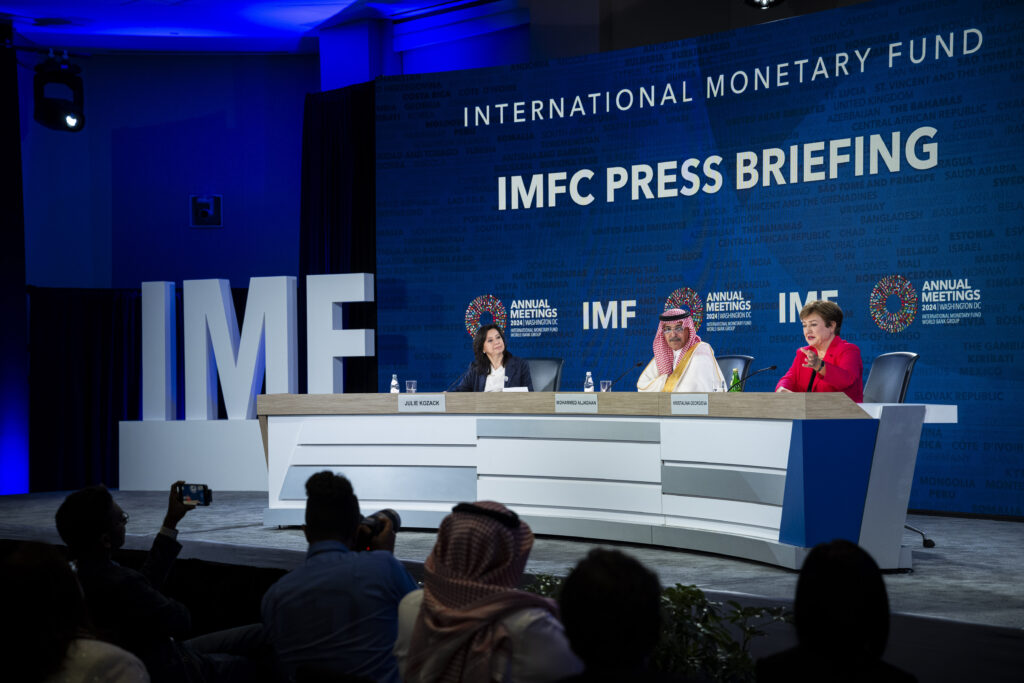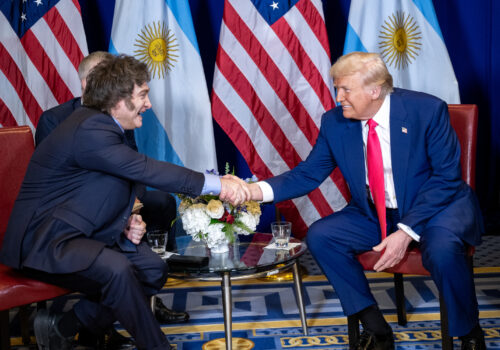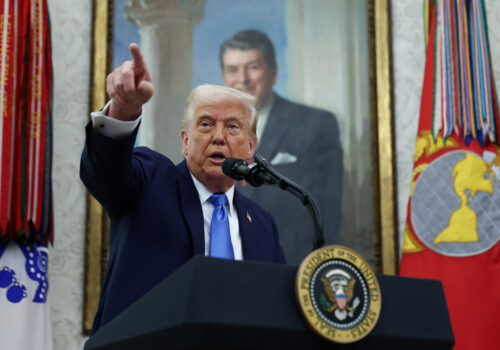US President Donald Trump’s stance on foreign aid has raised questions as to what approach he will take with regard to international financial institutions, and in particular the International Monetary Fund (IMF). But Trump also takes pride in recognizing a good deal when he sees one, and the IMF is indeed a good deal for the United States and the American people. The cost of US participation is low, but the role that the IMF plays in fighting financial crises is invaluable to supporting the US economy.
After four years representing the United States at the IMF, I can attest that the United States plays an outsized role at the institution. As US executive director, I engaged regularly with counterparts in regions such as Africa, the Middle East, and Latin America to help shape and support IMF lending in a manner that helped advance US interests and reduced Chinese influence. In this era of heightened uncertainty, the IMF could benefit from refocusing on its core priorities and helping countries stand on their own feet. Fortunately, the United States is well positioned to push for such reforms from within the institution. Should the United States instead opt to step back from the IMF, it would not only squander one of its most valuable international economic tools but would also open the door for China to play a lead role in an institution that has long supported US interests.
US participation in the IMF comes with significant leverage and burden-sharing
The IMF’s large resources (approximately one trillion dollars in loanable resources), broad membership, and ability to apply robust economic conditions enable it to prevent and mitigate economic crises. IMF lending catalyzes other donor finance from the World Bank, regional development banks, and official lenders to support fundamental economic reforms. US participation in the IMF yields roughly four to five times the leverage in terms of IMF lending—and even more leverage if incorporating lending from other donors. Put simply, for every dollar the United States lends, others lend at least four.
Economic crises can be costly to the United States, and Republican and Democratic administrations alike have turned to the IMF to be a first responder. The institution has for many years helped ensure economic stability in countries of strategic importance to the United States. In Ukraine, for example, the IMF is providing a $15.5 billion loan alongside US and European economic assistance—lending that is conditioned on Ukraine undertaking responsible fiscal policies and addressing corruption. IMF lending to Egypt, Pakistan, and Jordan has promoted sound fiscal and external policies, which in turn have supported both US security and economic interests. IMF lending to small African countries comes with specific conditions that require measures to strengthen anti-corruption and good governance, which in turn protects US investments in these countries. And IMF economic conditions are, by their nature, aimed at helping countries stand on their own feet and reduce their reliance on donor finance.
The IMF is an important counterbalance to China
The IMF also serves as an important counterweight to China by providing an alternative to opaque, unsustainable Chinese lending. In countries such as Ghana, Zambia, and Sri Lanka, the IMF played a pivotal role in securing Chinese cooperation to restructure unsustainable loans. Further, IMF surveillance of the Chinese economy also sheds light on the Chinese economic model, which relies on overcapacity in key sectors to employ its people and drive global prices lower—although the institution’s recent surveillance reports have not gone far enough to call China out on these unsustainable practices. Importantly, US influence in the IMF, particularly with regard to borrowing countries that have been recipients of the Belt and Road Initiative, serves as an important tool for US soft power.
The cost of US participation is low
US participation in the IMF costs next to nothing. The United States’ quota, the US financial contribution held at the IMF, acts as an exchange of assets: when the IMF draws on US quota assets (i.e. US dollars) to extend a loan to a borrowing country, it pays interest on these drawings using its Special Drawing Rights (SDR) interest rate. Thus, the cost of these loans to the United States is simply the interest rate differential between the interest the Treasury Department would have earned on the Treasury bonds and the interest it instead earned on the SDR.
Likewise, the United States is required to hold a small amount of its quota subscription in SDRs, and the cost of holding these funds in SDRs can be quantified by the valuation changes of the SDR relative to the dollar. As a result, the cost of US participation in the IMF is driven by the interest rate and exchange rate differentials between the US dollar and the SDR. In most years, this differential is quite narrow, since the US dollar makes up 43 percent of the SDR basket. Indeed, in fiscal year 2023, the Treasury Department reported a $407 million gain in unrealized returns from net valuation and interest in US participation.
Over the past twenty years, annual costs have netted out to roughly zero, with the exception of 2022, when large valuation effects generated a negative effect. Importantly, these annual gains and losses do not cost US taxpayer dollars; they simply represent an estimate of unrealized gains and losses from the use of the United States’ existing quota subscription.
In 2023, the United States negotiated an agreement at the IMF to raise overall quotas by 50 percent and eliminate bilateral borrowing credit lines. The quota agreement, if implemented, would be a boon for the United States. It would solidify the US majority share of 17.4 percent, which provides the United States with a veto over all major decisions at the IMF that require an 85 percent majority. It would also help reduce the likelihood that China could get a substantial increase in its quota share in the future. And it would reduce the influence over the IMF of countries that hold borrowing credit lines. Further, once authorized by Congress, the overall cost to the US taxpayer from an increase in US quota shares should be zero since this is a simple exchange of financial claims, or a swap of assets.
An agenda for Trump 2.0 at the IMF
When the United States speaks, the IMF listens, and when the United States pushes, the needle does move. The current administration should leverage US leadership to ensure the IMF is supporting US economic interests. The good news is that this does not require a wholesale reform of the IMF. But it does require the institution to evolve, and the current administration should actively press for some reforms.
Specifically, the United States should reinforce the message that the IMF needs to focus on what it does best: support macroeconomic stabilization and growth by focusing on sound fiscal, monetary, financial, and external sector policies. Now more than ever, these sound economic fundamentals are what will enable countries to weather heightened political and economic uncertainty and transitions in global trade. The IMF should make “back to basics” priority number one and leverage others’ expertise when it comes to issues outside of these core policies. The next US chair should use next year’s review of IMF surveillance policies to reexamine how best to serve its membership on nontraditional issues, such as climate, digital finance, and gender.
The United States should also press the IMF to call out the need for countries to raise domestic demand so as to narrow global external imbalances. In his speech to the Economic Club of New York on March 6, Treasury Secretary Scott Bessent said that “access to cheap goods is not the essence of the American Dream . . . for too long the designers of multilateral trade deals have lost sight of this.” The roots of this issue stem from policies by countries that hold current account surpluses, such as China, that promote a reliance upon external demand and an excess of savings. Deficit countries, such as the United States, also have a responsibility to run prudent fiscal policies. These concerns are not new; the Treasury Department has been raising the red flag on imbalances for many years, across Republican and Democratic administrations. Yet, the IMF continues to shy away from tough language for those countries that run massive current account surpluses and deficits. The IMF’s next annual External Sector Report, typically released in July, needs to be much bolder to include a clear message on policies that surplus and deficit countries can take to ensure global economic balances are sustainable—economically and socially.
The United States should also support efforts to enhance the effectiveness of IMF lending and help countries exit from IMF assistance. Under its Articles of Agreement, an IMF loan program must demonstrate how a borrower will resolve its balance of payments issue by the end of the program. However, the reality has been that many countries return to the IMF for multiple programs because reforms fall short of addressing the underlying economic issues—sometimes due to weak program design but often due to weak implementation and lack of political ownership.
Admittedly, some countries, particularly those that are low income, may require more than one program to tackle longstanding structural issues, but for many this is not the case. The IMF needs a strategy to help reduce repeat borrowing by designing economic conditions that will raise growth and address excessive debt burdens, and it needs to hold countries to implementation through its regular program reviews.
Finally, the Trump administration can solidify US leadership at the IMF by requesting that Congress approve a 50 percent quota increase in the upcoming fiscal year 2026 budget request. This would send a clear signal of US support and enhance the United States’ ability to achieve reforms. At the same time, the White House should signal to Congress a willingness to continue pressing the IMF to modernize and improve its operations and enhance efficiency.
The IMF provides the United States a significant source of economic leverage, helps prevent financial crises, and serves as a counterweight to China’s influence—all for a negligible cost. The most economical and effective move the Trump administration can play is to use US influence in the IMF to push for reforms that ensure the institution more effectively pursues its core mission in ways that are compatible with US interests.
Elizabeth Shortino is a nonresident senior fellow at the Atlantic Council’s GeoEconomics Center and a former US executive director at the International Monetary Fund.
Further reading
Mon, Mar 31, 2025
How Trump could upend global finance—and how the world might respond
AfricaSource By
Concerns are growing—particularly among policymakers and experts in “New South” countries—about the direction in which the international financial system is heading.
Wed, Feb 26, 2025
Milei came to Washington wanting freer trade. What would that mean for the US and Argentina?
New Atlanticist By Ignacio Albe, Valentina Sader
The Argentine president used his recent trip to Washington to call for closer trade relations with the United States. Here is what is at stake.
Mon, Mar 31, 2025
‘What you’re witnessing is a revolution.’ Making sense of Trump’s head-spinning moves.
Inflection Points By Frederick Kempe
As the past week made clear, the Trump administration is pushing ahead with what it sees as a revolution in the US approach to the world.
Image: Saudi Minister of Finance Mohammed Al-Jadaan, Chair of the IMFC, center, and IMF Managing Director Kristalina Georgieva, right, speak to media during an International Monetary and Financial Committee press briefing after IMFC meetings, during the ongoing International Monetary Fund and World Bank Group 2024 Annual Meetings, in Washington, D.C., on Friday, October 25, 2024. (Graeme Sloan/Sipa USA)




